Protein Crystallization Strategies for Structural Genomics
$109.95
IUL Biotechnology Series, 7
by Naomi E. Chayen (Editor)
Edition: First
Book Details:
- Series: IUL Biotechnology Series
- Volume: 7
- Binding: Hardcover
- Pages: 290
- Dimensions (in inches): 1.25 x 9.50 x 6.50
- Publisher: International University Line
- Publication Date: July, 2007
- ISBN-10: 0-9720774-3-X
- ISBN-13: 978-0-9720774-3-9
- Price: $109.95
1. Structural Genomics in the United States: The NIGMS Protein Structure Initiative 1 Abstract Getting from gene to structure involves many steps: cloning expression, solubilization, purification, crystallization, and only then, the determination of the structure. Once protein is pure and soluble, the key to crystallography is the availability of high-quality crystals. Producing high-quality crystals has always been the bottleneck to structure determination and with the advent of proteomics this problem is becoming increasingly acute. As a result, crystallization is gathering a new momentum as evidenced by the increasing numbers of commercial companies selling crystallization kits and tools, the increased investment of pharmaceutical companies in crystallization equipment and expertise, a high demand for practical courses in crystal growth, and the launch by the International Union of crystallography of a new Journal, Acta Crystallographica F, formed in 2005 for publishing the recent explosion of data concerning crystallization. The past five years have seen some of the greatest achievements in the field of protein crystallization. It is now feasible to screen thousands of potential crystallization conditions by dispensing trials consisting of nanoliter volumes in a high-throughput mode. This has cut the time of setting up experiments from weeks to minutes, a scenario that was unimaginable a few years ago. Even more incredible, is the revelation that diffracting crystals can be produced from protein samples in volumes as small as 5–20 nanoliter. The subsequent phase of image capture and analysis of the crystallization drops is also progressing in great strides. Surprisingly, in spite of the impressive advances accomplished, the crystallization problem has not been solved. High throughput has not yet resulted in high output and the current challenge is to design new and improved techniques (of screening and optimization) for the production of useful crystals. Scientists worldwide have taken on the challenge by tackling the crystallization problem from a variety of different aspects. Research advances in recent years have opened up the scope for the development of new methods and tools to overcome the bottleneck of protein crystallization. A variety of parameters that could previously not be explored are now accessible thanks to sophisticated apparatus and the development of new science-based techniques to monitor and control the process of crystallization. However, in order to become useful to the structural genomics effort, it is vital to miniaturize and automate these techniques and adapt them to cope with the vast numbers of “leads” resulting from the high-throughput screening procedures. Such efforts are those of the immediate future and the focus of this book. We are currently living in an exciting age, where for the first time ever, human diseases are being understood at a molecular level. Protein crystallography plays a major role in this understanding because proteins, being the major machinery of living things, are often the targets for drugs. The fuction of these proteins is determined by their three-dimensional structures hence a detailed understanding of protein structure is essential for rational design of therapeutic treatments. Structural genomics, or more accurately, structural proteomics, which aims to determine the structures of thousands of proteins has emerged as a direct consequence of the genome project in which the human genes and other genes have been sequenced. Structural Genomics projects worldwide are detailed in http://www.isgo.org/. Surprisingly, in spite of the impressive advances accomplished, the crystallization problem has not been solved. High throughput has not yet resulted in high output and the current challenge is to design new and improved techniques (of screening and optimization) for the production of useful crystals. Scientists worldwide have taken on the challenge by tackling the crystallization problem from a variety of different aspects. Research advances in recent years have opened up the scope for the development of new methods and tools to overcome the bottleneck of protein crystallization. A variety of parameters that could previously not be explored are now accessible thanks to sophisticated apparatus and he development of new science-based techniques to monitor and control the process of crystallization. However, in order to become useful to the structural genomics effort, it is vital to miniaturize and automate these techniques and adapt them to cope with the vast numbers of “leads” resulting from the high-throughput screening procedures. Such efforts are those of the immediate future and the focus of this book. This book’s aim is to assemble a selection of reviews highlighting the state of the art in techniques and strategies developed over the last four years for crystallization in the context of structural genomics. It is dedicated to the steps from the time of having pure protein to the crystallization, detection, imaging, and production of a diffracting crystal. Naomi Chayen
PROTEIN CRYSTALLIZATION STRATEGIES FOR STRUCTURAL GENOMICS
edited by
Naomi E. Chayen
Contents
Preface xiii
List of Contributors xv
Charles G. Edmonds and John C. Norvell
2. A Guide to Automation and Data Handling in Protein Crystallization 9
Bernhard Rupp
2.1. Introduction 11
2.2. High-Throughput Protein Structure Determination 13
2.2.1. Why High Throughput? 13
2.2.2. Definition of High Throughput 13
2.2.3. High Throughput versus Low Throughput 14
2.2.4. Estimation of Throughput 14
2.2.5. The Data Explosion 17
2.2.6. Information Technology Infrastructure 18
2.2.7. Data Mining and Machine Learning 19
2.3. Overview of Protein Crystallization 21
2.3.1. Basics of Protein Crystallization 21
2.3.2. Experimental Crystallization Setup Techniques 23
2.3.3. Experimental Design Considerations 25
2.3.4. Crystallization Screening as a Sampling Problem 26
2.3.5. Robotics and Flexible Design Strategies 26
2.4. Implementation of Robotic Technology—General Considerations 28
2.4.1. Efficiency versus Throughput 29
2.4.2. Patent and Licensing Issues 30
2.4.3. Service and Maintenance 31
2.5. Implementation of Robotics in the Academic Laboratory 31
2.5.1. Objectives and Cost 32
2.5.2. Bottlenecks 33
2.5.3. Kits versus Custom Cocktails 34
2.5.4. Limitations to Full Automation 35
2.5.5. Two Basic Automation Scenarios 35
2.6. Instrumentation 36
2.6.1. Liquid Handling Stations 36
2.6.2. Plate-Setup Robotics 38
2.6.3. Sealing 41
2.6.4. Visualization 41
2.6.5. Plate Handling and Storage 42
2.6.6. Fully Integrated Systems 45
2.6.7. Cryoprotection 45
2.6.8. Robotic Sample Mounting 46
2.7. Conclusions 49
3. Automated Liquid Handling Systems for Submicroliter Crystallization 57
Terese Bergfors
3.1. Introduction 59
3.1.1. The Development Path of Crystallization Robotics 59
3.1.2. The Shift Towards Nanoliter Crystallization 60
3.1.3. Advantages of Crystallization on the Nanoliter Level 61
3.1.4. Future Robot Technology for Crystallization 62
3.2. Choosing a Robot 63
3.2.1. Background of This Chapter 63
3.2.2. What are the Automation Requirements? 63
3.2.3. Multiuser or Service Laboratory? 63
3.2.4. Reservoir Filling and Cocktail Production 64
3.2.5. Types of Dispensing 65
3.2.6. Accuracy and Precision 67
3.2.7. Speed and Related Issues of Chilling and Evaporation Control 68
3.2.8. Size 69
3.2.9. Price 70
3.2.10. Product Descriptions 70
Appendix 3.1. Product Ddescriptions of the Crystallization Robots Listed in Table 3.1 73
4. Soft-Polymer Microfluidic Applications to Protein Crystallization 87
James M. Berger
4.1. Introduction 89
4.2. Classic Crystal Growth Methods 91
4.3. Microfluidic Platforms for Crystallization 94
4.4. Capabilities Unique to Microfluidic Devices 97
4.5. Microfluidic Phase-Space Mapping 100
4.6. Horizon Methods 100
4.7. Conclusion 103
5. Counter-Diffusion Capillary Crystallization for High-Throughput Applications 111
Juan M. Garcia-Ruiz and Joseph D. Ng
5.1. Why Counter-Diffusion Crystallization? 113
5.2. Principle of Counter-Diffusion Crystallization 114
5.3. Preparation and Setup 115
5.3.1. Single Capillar 116
5.3.2. Multiple Array Configurations 116
5.4. Getting the Protein Crystal to the X-ray Beam as Soon as Possible 118
5.4.1. Taking a Walk Down Crystal Lane 120
5.4.2. Mounting and Aligning Crystals in Capillary 121
5.4.3. Preliminary X-Ray Analysis 121
5.4.4. Data Collection and Electron Density Calculation Image Processing 122
5.5. Important Points 124
6. Scale-Down Approaches for Measuring Protein-Protein Interactions 127
Joseph C. Fanguy, Charles S. Henry, Steven C. Holman, Joseph J. Valente, and
W. William Wilson
6.1. Introduction 129
6.2. Scale Down of Static Light Scattering 133
6.2.1. Configuration Description 133
6.2.2. Flow Injection Components 136
6.2.3. Data Acquisition System 137
6.2.4. Samples for Demonstration Purposes 137
6.2.5. Results for Demonstration Proteins 138
6.3. Scale Down of Self-Interaction Chromatography 143
6.3.1. Evolution of Self-Interaction Chromatography (SIC) 143
6.3.2. The Synergy of B and SIC 144
6.4. B and Solubility 146
6.5. Potential for Miniaturization 147
6.6. Conclusions 149
7. Gearing Optimization Techniques Towards High-Throughput 153
Naomi E. Chayen
7.1. Introduction 155
7.2. Development of Optimization Procedures 156
7.2.1. Crystallization in Gels 157
7.2.2. “Containerless” Crystallization 159
7.2.3. Control of Evaporation Kinetics 160
7.2.4. Optimization by Decoupling Nucleation and Growth 161
7.2.5. Slowing Down Vapor Diffusion with an Oil Barrier 162
7.3. Summary 163
Appendix 7.1. Experimental Procedures 166
A7.1.1. Preparation of Gels 166
A7.1.2. Control of Evaporation 166
A7.1.3. Decoupling of Nucleation and Growth 167
8. Miniaturization and Automation for High-Throughput Membrane Protein Crystallization
in Lipidic Mesophases 169
Vadim Cherezov and Martin Caffrey
8.1. Introduction 171
8.2. The In-Meso Crystallogenesis Robot Suite 174
8.2.1. Crystallization Robot 174
8.2.2. Screen Solution Preparation 174
8.2.3. Crystallization Plates 175
8.2.4. Imaging Station 176
8.3. Crystallization Trials 176
8.3.1. In-Meso Crystallization 176
8.3.2. Screening 177
8.4. Robot-Performance Characterization 178
8.5. Crystallization Plates 179
8.6. Crystallization Robot 181
8.6.1. Dispensing the Lipidic Cubic Phase 181
8.6.2. Dispensing the Precipitant Solution 184
8.6.3. Dehydration during Setup 185
8.7. Imaging Station 187
8.7.1. Performance Characteristics 187
8.7.2. Image Processing 188
8.8. Crystallization Trials 189
8.9. Quo Vadis? 189
8.10. Conclusions 192
9. Automated Classification of Crystallization Experiment 359
Julie Wilson
9.1. The Need for Automated Classification 197
9.2. Edge Detection 198
9.3. Image Cropping 203
9.4. Artifacts not Related to the Crystallization Experiment 203
9.4.1. Bubbles and Droplets 204
9.4.2. Plastic Mold Effects 204
9.5. Masking the Drop 205
9.5.1. Circular Masks 205
9.5.2. Noncircular Masks 20
9.6. Analysis of the Crystallization Drop 208
9.6.1. Feature Extraction 209
9.6.2. Object-Based Features 209
9.6.3. Drop-Based Features 212
9.7. Classification 214
9.7.1. Learning Algorithms 214
9.7.2. Decision Trees 215
9.7.3. Linear Discriminant Analysis 216
9.8. Summary 217
Index 221
Preface
Getting from gene to structure involves many steps: cloning, expression, solubilization, purification, crystallization, and only then, the determination of the structure. Once protein is pure and soluble, the key to crystallography is the availability of high-quality crystals. Producing high-quality crystals has always been the bottleneck to structure determination and with the advent of proteomics this problem is becoming increasingly acute. As a result, crystallization is gathering a new momentum as evidenced by the increasing numbers of commercial companies selling crystallization kits and tools, the increased investment of pharmaceutical companies in crystallization equipment and expertise, a high demand for practical courses in crystal growth, the launch by the International Union of Crystallography of a new journal, Acta Crystallographica F, formed in 2005 for publishing the recent explosion of data-concerning crystallization, and the establishment of the International Organization for Biological Crystallizaion (http://www.iobcr.org).
The past five years have seen some of the greatest achievements in the field of protein crystallization. It is now feasible to screen thousands of potential crystallization conditions by dispensing trials consisting of nanoliter volumes in a high-throughput mode. This has cut the time of setting up experiments from weeks to minutes, a scenario that wasunimaginable a few years ago. Even more incredible, is the revelation that diffracting crystals can be produced from protein samples in volumes as small as 5–20 nanoliter. The subsequent phase of image capture and analysis of the crystallization drops is also progressing in great strides.
Most researchers involved in HTP consortia are engaged in solving structures and do not have the time or inclination to develop new methodology for crystallization. I have therefore chosen most of the Authors form the crystal growth community, for their expertise in development of methodology in their respective fields within crystallization.
The first chapter provides a background to structural genomics describing how it was conceived, funded, and implemented in the USA. This is just one example of many excellent Structural Genomics projects
taking place worldwide (see http://www.isgo.org/) that could compile a book in their own right.
Chapter 2 provides an overview of setting up high-throughput structural proteomics projects in different environments and guidance as to how to handle the data and know-how resulting from the numerous experiments.
Chapters 3-5 describe different ways of conducting high-throughput initial screening for obtaining the first leads for crystallization. Chapter 3 reviews the current robotic systems for screening that are available on the market for conducting high-throughput crystallization trials. Until 2002, screening for initial crystallization conditions was performed almost exclusively using vapor diffusion and microbatch. Since then, screening by the free interface and counter-diffusion methods that were least used in the past due to handling difficulties and the requirement for large quantities of sample, have been miniaturized and automated thus gaining a new lease of life. Chapters 4 and 5 deal with miniaturization and adaptation to high throughput utilizing free interface and counter diffusion and gels, the former by microfluidics and the latter, using capillaries.
Chapter 6 describes a procedure for screening with a built-in optimization. Screening is performed using the standard screening kits but instead of looking for leads such as crystals, precipitation etc, the aim is to find the conditions that are at the metastable zone, which contains the ideal conditions for crystal growth.
Chapter 7 deals with strategies to optimize and improve the crystal quality once a lead has been obtained. These are methods that have been performed mainly manually and have recently been automated in order to adapt them to high-throughput experiments.
Chapter 8 describes the miniaturization and automation of experiments with membrane proteins in liquid cubic phase.
Dispensing trials with such amazing speed and ease has raised the issue of observation and monitoring of the vast numbers of trials. Major effort is currently being invested in designing image processing equipment for automated follow-up and analysis of the results as described in Chapter 9. Full automation of the visualization and monitoring of trials is expected to be the next major breakthrough in the field of crystallization.
The success rate of obtaining high-quality crystals is improving and the coming years promise to bring further advances in the more complex techniques that will play a major role in crystallization and proteomics. This will raise the rate of producing high-quality crystals, and will equip the genome project to deal with its awesome task.
London, England, May 2007
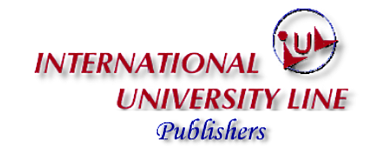
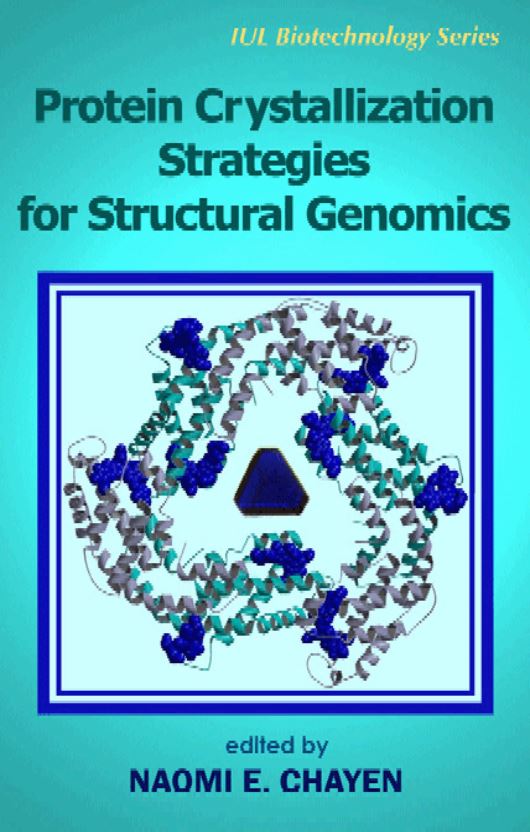
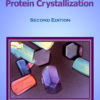
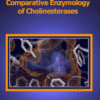
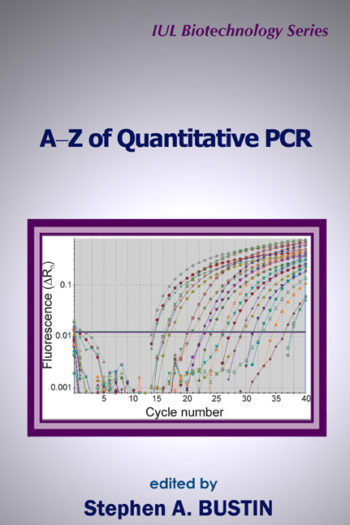
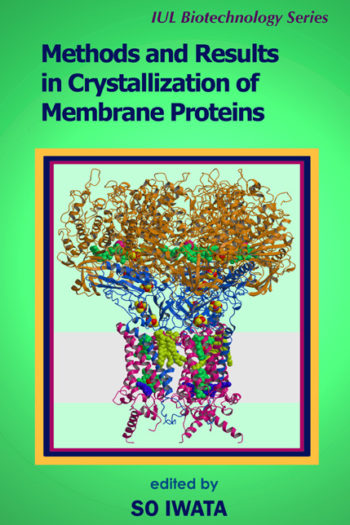
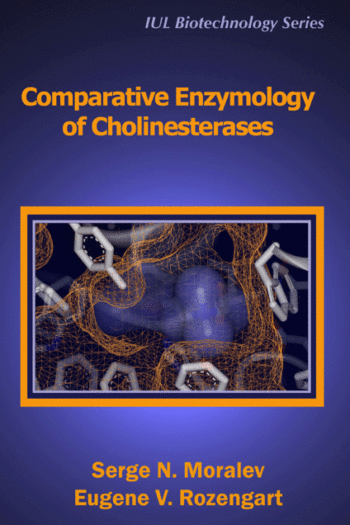

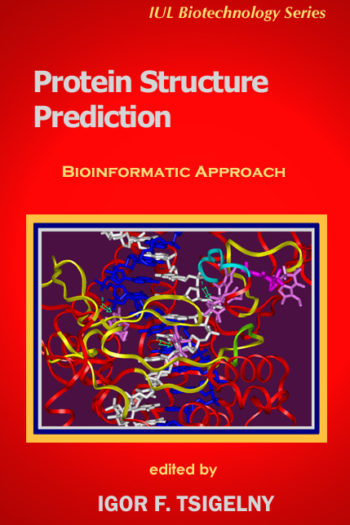
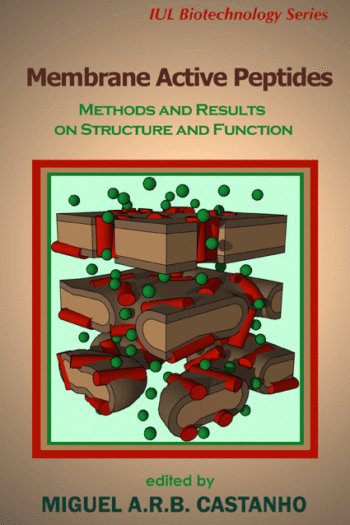

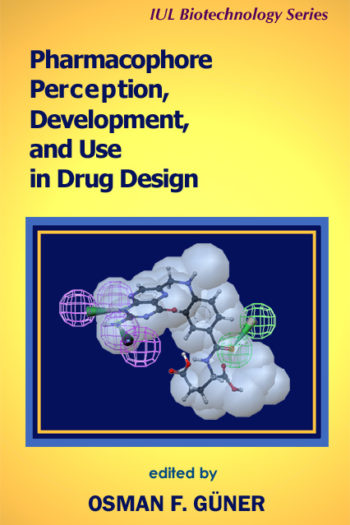
Raymond C. Stevens –
Professor, The Scripps Research Institute, La Jolla, California
During the 1980s and early 1990s, we observed a tremendous breakthrough in our understanding of the physical chemistry of macromolecular crystallization due to the pioneering efforts of several leaders in the field. However, the determination of protein 3-dimensional structure was still a slow process, often taking years to complete. In the mid to late 1990s, a new renaissance of protein crystallography occurred with the development of increased throughput nanovolume crystallization robotic methods, microfluidic counter diffusion, creative screens and optimization techniques, crystal imaging, and novel crystallization methods for the very challenging membrane proteins and large macromolecular complexes. In the fast paced world of high throughput protein crystallization, this work was established by many of the authors in this book and the areas are comprehensively covered. Protein Crystallization Strategies for Structural Genomics will be highly valuable to those experimentalist interested in understanding, reproducing, or expanding upon the recent innovations. It will be an essential reference for the many small and medium size laboratories that are starting or are planning to adopt these systems and approaches. The clarity, thoroughness, and simplicity of the chapters are impressive. The best analogy for this compendium is the early days of gene sequencing when technology development was critical in moving radioactive gel sequencing to fluorescent capillary automated methods. This book is the beginning of a similar movement, initiating the vision of rapid macromolecular structure determination for providing a deeper understanding of the molecular science of life. What this book accomplishes and that many other similar books miss are the critical details necessary to understand, and further expand upon protein crystallization strategies for structural biology.